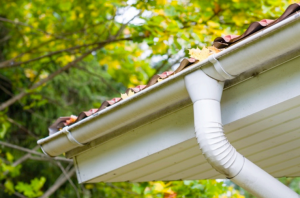With rain finally making its appearance in the northwest, the time to check our houseʼs water defense has come! Your gutter system exists to direct water away from the house. Without it, the water would be allowed to flow into unwanted areas, causing damage to lower parts of the house. This can range from mold in the walls, to more serious problems such as damage to the foundation. Because of this, gutter maintenance is crucial to your homeʼs longevity. Taking time to keep them maintained and being quick to make repairs can as much as double the life of your drainage system. So letʼs cover some of the basics.
 As a general rule, gutters should be examined semi-annually. Ideally before the rain comes: fall, when the leaves are changing and the sun is being hidden by more clouds, and spring, just before the heavier rains make their appearance. The first thing you should look for are clogs. Leaves, dirt, and other debris will create buildup that will prevent the water from flowing normally. Most of your clogging is likely to occur at the elbow of a gutter:that is, where the gutter connects to the downspout. Occasionally, the downspout itself can
As a general rule, gutters should be examined semi-annually. Ideally before the rain comes: fall, when the leaves are changing and the sun is being hidden by more clouds, and spring, just before the heavier rains make their appearance. The first thing you should look for are clogs. Leaves, dirt, and other debris will create buildup that will prevent the water from flowing normally. Most of your clogging is likely to occur at the elbow of a gutter:that is, where the gutter connects to the downspout. Occasionally, the downspout itself canget clogged. If water goes into the elbow and does not come out the bottom, you may need to check it. Pay attention to hangovers such as trees, as this can create a need for more frequent cleaning. When examining your gutters, watch also for rust, as it can cause leaks.
One important aspect of a working gutter is the pitch. Your gutter should be leveled with a drop of approximately a sixteenth of an inch for each foot of length. You can check this a couple ways: with a chalk line and level, if you want to be very precise, or a simple way of pouring water into it, and simply watching the flow. The water should all run out without leaving any puddles or pools. If you find stagnate water, you have a low spot. To fix a low spot, check the gutter hangers. Most gutters are hung with either straps or brackets. You can add either of these to lift low spots. Itʼs best to choose one already used with the gutter.
A good prevention measure to take is to use a leaf guard and strainer. Strainers are inserted at the elbow of the downspout, and allow water to flow but prevent leaves and other large debris from entering. These are inexpensive and easy to install. Leaf guards, which can be found in metal or plastic, are similarly easy to install. The leaf guard covers your entire gutter system. Placed on top of the gutter, and underneath the first shingles of the roof, these will stay in place and keep out unwanted debris. Leaves that end up on top of the guard will often blow away on their own once dry.
If you find you have leaks in your gutter, it may be time to replace it. Depending on the size of the leak, some can be repaired, while others are telling you that section has met its end. When you find a leak that you cannot repair, you may be able to replace just the section itʼs in. If you are finding multiple leaks throughout, donʼt discount investing in a whole new system. Remember that a working gutter will protect your foundation. For a small leak in a gutter that is overall in good condition, you can repair it by covering it with a layer of plastic cement specifically designed for gutter repairs. If doing this, first clean out debris, and remove as much rust as you can from the area youʼre going to cover. You can scrape off rust with a steel brush. This is important to prevent the rust underneath the cement from spreading, causing a larger hole down the line.
When your gutter and your downspout are both in good working order, the rain will not be an adversary against your homeʼs stability. Maintenance for these, while simple, is important and effective. If you are having problems that you cannot pinpoint, or are more significant than the minor common issues covered here, call a professional to help. If you have concerns about possible damage from old leaks or poor drainage, you may also want to have your home inspected. For a qualified home inspector, go to:
A small investment now can save you on major repairs water damage can have down the line. Your home is worth that!
No comments:
Post a Comment